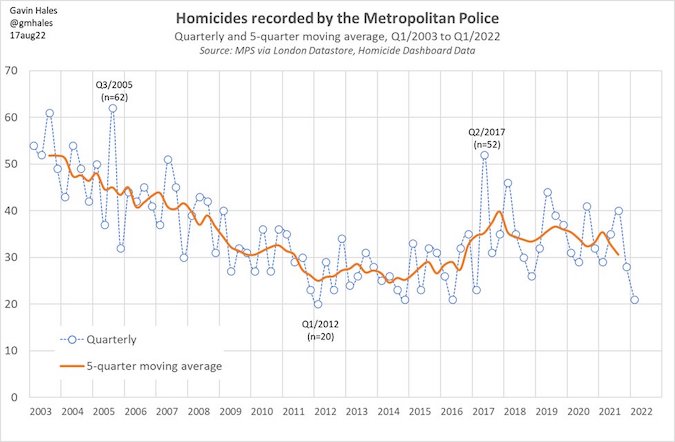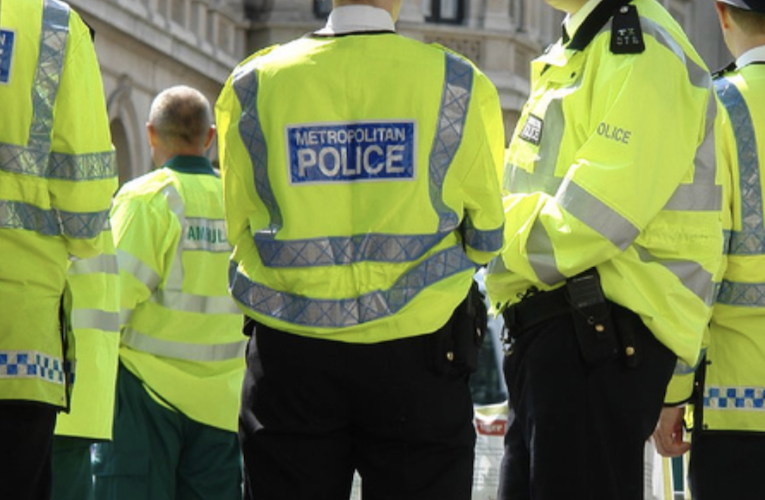Film footage has been published of a street robbery in Chelsea, including by the Evening Standard. It is frightening, distressing and angering. Darren Grimes, a pro-Brexit campaigner who presents a television programme called Real Britain, has responded to the footage on Twitter. “Honestly, I love our capital city,” he wrote. “It breaks my heart to see it devolve (sic) into this lawlessness that’s spreading like wildfire.”
Claims that “lawlessness” in London has become rife and is increasing rapidly are not uncommon among people working in some sections of the media. Another television presenter, Dan Wootton, who also writes a column for the Daily Mail, responded to the horrible killing of 87-year-old Thomas O’Halloran in Greenford by characterising the capital as “Sadiq Khan’s Lawless London” and calling for an end to what he said is a “tolerance for violent crime” in the city. Wooton has been pinning the label “lawless” on London for some time, and always links Mayor Khan to this “lawlessness”, which is, of course, a way of saying the Mayor is to blame.
Such claims raise a number of questions. Is “lawlessness” in London “spreading like wildfire” as Grimes declaimed? Has London become increasingly “lawless” under the current Mayor, who was first elected in May 2016, as Wootton implies?
The robbery in Chelsea involved violence against a woman and, from the look of the footage, quite possibly injury to her. Violent offending in London, especially when victims are injured, is something vanishingly few Londoners want more of and has been the object of repeated media focus for many years, including recent ones.
What has been the trend in the category of violent crime with injury, excluding homicides, according to Metropolitan Police statistics? Met figures show that for the financial year 2017/18, covering the period from the start of April 2017 until the end of March 2018, the number of cases of violence against the person with injury it recorded was 77,549. The number for 2018/19 was 78,141. For 2019/20 it was 76,355.
That takes us up to the start of the pandemic and its lockdowns, which saw reductions in reports of crimes in several categories, almost certainly due to people being inside more. The figure for 2020/21 dropped to 65,668. For 2021/22, during which lockdown rules were removed, the figure rose again, reaching 76,199 as recorded to the end of March this year. Coming further up to date, the 12 month period to the end of this July sees the number of violence with injury cases currently recorded by the Met standing at 77,414.
These annual figures often undergo adjustments by statisticians for various technical reasons, but those applied to the Met figures used in this article have been small – less than 200 either way. And the overall picture for Met-recorded cases of violent crime with injury over the past five years has been one of very little year-to-year change: excluding the highly atypical 2020/21, it has varied only slightly – between 76,355 and 78,141 – and there has been no consistent upward trend.
Similarly, to get a realistic picture of homicide trends in London it is necessary to look at what has happened over several years, not a few days. The number of homicides in London for the financial years 2017/18 to 2021/22 are as follows. For 2017/18, 163. For 2018/19, 122. For 2019/20, 145. For 2020/21, 119. For 2021/22, 124. Again coming further up to date, the number of homicides reported during the 12 months to the end of July was 114.
Crime and policing researcher Gavin Hales has recently looked back further and mapped Met homicide figures since 2003. As his graph below shows, there was a long and pretty steady fall in the number of homicides from the start of that period, which roughly bottomed out from about 2012 to about 2015 or 2016 before rising again – though not as high as the previous heights – and then returning to an overall, if uneven, downward path.

That is not the story Dan Wootton told on Twitter. He depicted the particularly chilling killing of Thomas O’Halloran and the other recent killings in London, all of which occurred within a few days of each other, as evidence that violent crime in London is increasing fast. Yet the homicide figures show that the number of killings in London has been mostly falling for a few years while, as shown above, those for violence with injury have stayed pretty much the same.
There have been no media reports of homicides in London since that of O’Halloran on 16 August. If Wootton believes six murder investigations beginning over the course of four days is evidence of violent crime escalating, it would be consistent of him to herald no murder investigations beginning over the course of nine days as proof that violent crime in London is falling fast – and to congratulate Sadiq Khan. That does not appear to have occurred.
The television programmes of Grimes and Wootton are broadcast by GB News, a right-wing television channel with a small but loyal viewership. Its presenters making unsubstantiated claims about violent crime rates in London which are at odds with several years of Metropolitan Police crime statistics benefits almost no one. Almost.
On London strives to provide more of the kind of journalism the capital city needs. Become a supporter for just £5 a month. You will even get things for your money. Details here.

